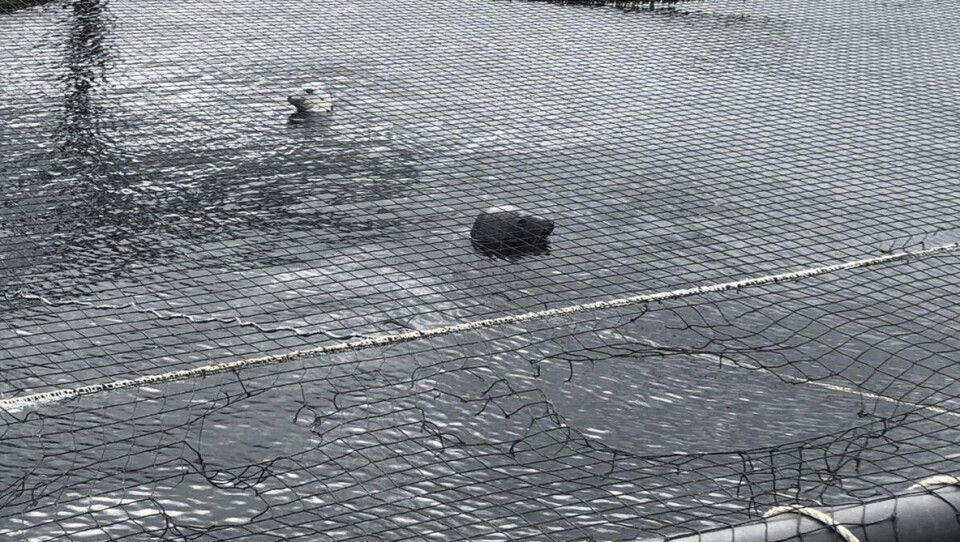
Salmon farmers ditch ‘disturbing’ seal deterrents
Scotland’s salmon farmers are no longer using acoustic deterrent devices (ADDs) that may have been considered to cause disturbance to European Protected Species, the Scottish Salmon Producers’ Organisation (SSPO) said today.
ADDs have been used to deter seals from attacking fish pens, but the only circumstances in which salmon producers will use them in future is where they comply with both Marine Scotland and US Marine Mammals Protection Act (MMPA) requirements and operators have been provided with evidence from suppliers of the devices’ compliance.
The SSPO announcement coincides with a Marine Scotland report into ADDs to be laid before the Scottish Parliament today. Scotland’s salmon farmers are awaiting guidance from the Scottish Government and the US on the use of anti-predation devices.

Turned off and removed
SSPO sustainability director Anne Anderson said: “Scottish salmon farmers are not using any acoustic deterrent devices that may have been considered to endanger cetaceans such as dolphins, porpoises and whales. All devices the sector does not have total confidence in, with regards to the harming of protected species, have been turned off and removed from the marine environment.
“It is critical however that farmers have deterrents available to protect their livestock from seal predation. As such the Scottish salmon farming sector is committed to, where necessary, only using acoustic devices that have been scientifically proven to be compliant with the US MMPA.
“We call on Marine Scotland to work with the sector to develop a science-led approach which enables the use of deterrent devices and supports research and innovation in this area to ensure that farmers can continue to deploy these tools, which play a useful role in managing seal predation and improving animal welfare.”
Further research
ADDs are used by a number of marine sectors including offshore construction and engineering to deter marine mammals from installations, to protect animals, people and infrastructure.
They have been used by some salmon producers as part of the toolkit for managing predation by seals, in conjunction with other deterrent technologies and innovations including anti-predation netting, seal blinds and new net tensioning methods.
The SSPO said salmon farmers recognise and welcome the value of further research to refine and enhance acoustic devices that can protect farmed fish without disruption to other species. This has included working with several academic institutions to develop the science in this field.
Different frequencies
New generation acoustic deterrent devices have been developed to use a different range of frequencies and volumes to help deter seals, while better safeguarding cetaceans.
A change in legislation by the Scottish Government means salmon farmers have already lost the option to carry out licensed shooting of seals that weren’t deterred by ADDs or other methods.
That change was enacted to ensure fish could still be exported to the US, but some believe it was brought in too quickly, without allowing time for companies to carry out complicated infrastructure changes on farms to protect fish from seals in other ways.
The Scottish seal population is increasing, and in 2020 more than 500,000 Scottish farmed salmon were killed in seal predation attacks.
Lower average volumes
One ADD manufacturer, Ace Aquatec, welcomed today’s announcement by the SSPO. The Dundee-based firm said new legislation requiring licences for work which may disturb or injure European Protected Species was aimed at addressing old-style of acoustic deterrent devices which often worked at loud average volumes and higher repetitive frequencies.
New generation acoustic deterrent devices, such as those developed by Ace Aquatec, can operate at lower average volumes and optionally at lower frequencies, that are clearly audible to target species such as seals but are less audible to protected cetaceans including porpoises and dolphins. New generation devices with wider frequencies ranges and modulation capabilities are more selective and responsive and so can be much more effective at lower sound levels.

MMPA compliance
Ace Aquatec chief executive Nathan Pyne-Carter said: “Our cutting edge deterrent innovation has been supported by a number of Scottish Government grants, including from SMART: Scotland and Cefas, to help us bring to the market an alternative to the previous style of devices.
“We are pleased to hear that the industry has committed to use next generation deterrents like those that we manufacture in the UK and distribute globally.
“Scottish fish farmers have a legal and moral duty to protect the welfare of their fish and the losses caused by seal attacks can have a significant financial and operational impact on a key Scottish sector which is currently also facing many other challenges.
“We are pleased that our devices have secured MMPA compliance and we are committed to working with the Scottish marine and aquaculture sector for further research into the use of ADDs and animal safety. We also have a SAIC (Sustainable Aquaculture Innovation Centre) grant currently ongoing to look at underwater sound propagation and the use of artificial intelligence triggering systems.”






















































